Feeding a Venus flytrap is a unique and fun experience. Venus flytrap benefits from capturing prey and consuming bugs. In this article, I would like to share what I have learned about feeding Venus flytraps, including food options and the feeding method.
Venus flytraps capture and consume insects and arachnids to extract critical nutrients and supplement their diet. Venus flytraps can consume a variety of arthropods, such as flies, crickets, spiders, worms, ants, beetles, and slugs.
Now, let’s choose which food option is the most viable for you and continue with an overview of the feeding process. Feeding Venus flytraps is not very hard, but improper procedures can harm your plant. The instructions below will guide you through the process.
Venus Fly trap Feeding Fact Summary
| Suitable food options | Live or dead bugs, such as spiders, worms, flies, bloodworms, mealworms, crickets, beetles, gnats, ants |
| Harmful food options | Human food: meat, chicken, sausage, fruit, candy, etc |
| Feeding requirement | Feeding is not a requirement for survival, but can offer some benefits. |
| Feeding frequency | Feed 1-2 times a month for indoor plants and 0 for outdoor plants as they capture their own food |
| Food size | Select bugs that are no larger than 1/3 of the size of the trap you intend to feed |
| Food livelihood | Bugs can be dead or alive for feeding, however, the process will vary depending on their state |
Venus Flytrap Food Options
Venus flytraps are native to the wetlands of South Carolina and North Carolina in the United States. There, they grow in inferior soil, with no access to nutrients. Over the years, Venus flytraps have evolved to be successful predatory plants.
Venus fly traps consume bugs to extract key nutrients and supplement their diet. However, feeding them is not a requirement; It is just a supplement. You can choose to never feef your plant or just grow it outdoors where it can capture its own food.
In terms of food options, you must pick an appropriate meal in terms of size and decide if you prefer to employ live or dead feed.
Venus flytraps are not picky eaters. They can consume almost any type of insect or spider that is dead or alive and fits inside their traps.
Venus flytrap can only consume bugs that fit inside their traps. Usually, a bug that is about 1/3 of the size of the trap should fit completely in it. Depending on the size of your venus flytrap you can consider the options below. You must also decide between live and dead feed.
Store Bought Options
- Freeze-dried Mealworms (link to buy on Amazon: https://amzn.to/3P5vNiE
 )
) - Freeze-dried Bloodworms (link to buy on Amazon: https://amzn.to/45TXtgn)
- Dried crickets
- Live crickets
- Live fruit flies
- Live worms
You do not have to capture bugs for your Venus flytrap. It is very easy and inexpensive to buy feed in pet stores. The items in the store-bought list are very common items in pet shops as they are used to feed reptiles and fish.
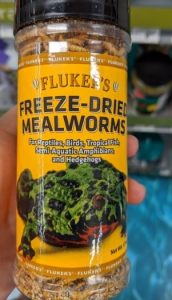
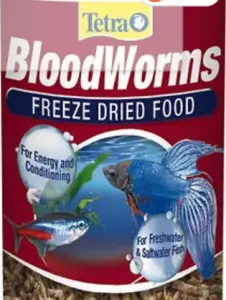
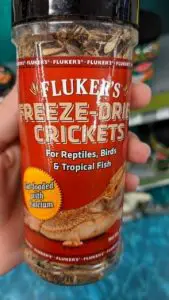
The first three options: dried crickets, freeze-dried mealworms, and bloodworms, are all dead feed. They have been dried up and dehydrated. Before feeding to a Venus flytrap, you must use water to rehydrate the bugs. The convenient thing about these three options is the price and durability. A single package with thousands of worms or crickets costs only 5 to 10 dollars. And it can be stored for several years. Besides, the three options are highly nutritious. You might think dead bugs might provide fewer nutrients, but that is not necessarily true. For example, the mealworms in the picture are made up of about 45% protein.
I buy these freeze-dried bugs in the pet store as they are very affordable, can last you for years, and are extremely nutritious. The link will take you to Amazon to review the prize, they are usually less than $10.
in the pet store as they are very affordable, can last you for years, and are extremely nutritious. The link will take you to Amazon to review the prize, they are usually less than $10.
Pet stores also offer live feed options, as some pets won’t eat dead bugs. Consider buying live crickets, fruit flies, or worms to feed your Venus flytrap. They cost about 5 to 12 dollars. Keep in mind live bugs have a limited life expectancy. So, you must buy them when you are ready to feed your plant.
Other Food Options
- Flies
- Ants
- Gnats
- Caterpillars
- Spiders
- Beetles
- Slugs
- Grasshoppers
- Worms
- Crickets
Against popular belief, Venus flytraps not only consume flies, but also other types of insects. You can experiment with different types of feed with your plant. Any of these options will provide good nutritional values. Some bugs are more difficult to use as carnivorous plant food than others. Here are a few considerations:
Ants and Gnats: They are great candidates for young Venus flytrap due to their size. But, feeding ants or gnats to large Venus flytrap can be a challenge. Sometimes these bugs are too small to activate the traps or they might escape before the lobes are fully close.
Slugs and Caterpillars: Be aware that these insects can give a ferocious fight to escape. Slugs and caterpillars can attempt to eat their way out of the plant.
Crickets and Grasshoppers: These two bugs are difficult to handle when they are alive. Make sure to practice picking them up with a set of tweezers or with your hands.
Dead vs Live Feed
Venus flytraps can consume either dead or live feed. This article I wrote contains a full list of venus flytrap food options. There are no extra nutritional or health benefits to choosing one on top of the other. However, the feeding process varies, and the decision should be based solely on your preferences.
- Personality: Some people enjoy handling live bugs and are excited about feeding them to carnivorous plants. Others are not so interested in live prey.
- Convenience: You can buy dead feed and store them for a few years without having to worry about buying more food for your plant. Buying and storing live food is more expensive and time-consuming.
- Extra skill: Employing live feed takes some skill. You need to be comfortable handling moving insects. And master the technique to avoid losing the bug.
- An extra step in the feeding process: In nature, Venus flytraps only consume live food. When you feed them dead bugs, you will need to follow one extra step to ensure your plant does not lose interest in the dead prey.
The Best Food Options
I have experimented with different types of feed for several years. Some tend to be a lot more effective than others. Here is my recommendation for Venus fly traps:
Live or dried-up mealworms or crickets are some of the best options for Venus fly traps, as they provide an extensive nutritional value, they are easy to digest, and readily available in most pet stores.
Dried up versions provide very similar benefits to live ones, however, the process of feeding dead bugs produces more stress to the plant. Overall, I prefer to go for live bugs when they are available.
The Worst Food Options (Avoid at all costs!)
The vast majority of insects and spiders will work great for Venus fly traps, with very few exceptions like a snail which tends to be difficult to digest. However, there are some food options which you should always avoid.
Never feed human food to Venus fly traps, avoid chicken, meat, candy, or fruits. Venus fly traps are unable to digest human food. Employing it will cause the leaf to die and the food to rot over time attracting possible pests.
Venus Flytrap Feeding Basics
This section will help you master the feeding process with live and dead food. First of all, let’s start by learning some basic tips:
- Outdoor Venus flytraps do not need to be fed: In the outdoors, Venus flytraps capture their own food. They do not need human help to capture bugs.
- The bug size matters: Never focus on feeding large bugs to Venus flytrap. Instead, follow this rule: only feed your plant bugs that fit entirely inside the trap. If the insect is too big, the plant won’t be able to digest it. In terms of nutritional value, even small bugs can provide enough nutrients for a mature plant.
- Only feed one trap at a time: Just a single bug is enough for the whole plant. Select a trap and feed just that trap. You can alternate between feedings, but never attempt to feed multiple traps at a time.
- Avoid overfeeding: Overfeeding a Venus flytrap can be harmful to the plant. The plant can start losing leaves if it gets overwhelmed with all the food. Only feed Venus flytrap once every 2 to 6 weeks. The digestion process can take up to two weeks, so make sure the plant has finished the previous meal before you introduce a new one.
- No need to feed dormant plants: In the winter, Venus flytrap experience dormancy, which is similar to hibernation. During this process, there is no need to feed them.
- Stick to an exclusive bug diet: The previous section contains plenty of food options for Venus flytrap. Stick to those alternatives and other insects or spiders. Do not experiment with human food. Venus flytrap can digest candy, chicken, fruit, hamburgers, or any human food.
- Watch the leaves after feeding: After you feed a leaf, observe it for the next weeks. The plant will at least a week to digest the bug. If the leaf starts dying, in the middle of the digestion process, you might have chosen an excessively large bug.
Venus Flytrap Feeding Procedure
In this section, you will learn how to feed a Venus flytrap. The feeding procedures vary slightly between the dead and live feed options.
Feeding Dead Bugs
Step 1: Prepare the bug
Dead bugs from the pet store usually are dehydrated. Before you feed one to a Venus flytrap, you must rehydrate the bug. Use a few droplets of distilled water to hydrate it. If you are using a dead bug you caught or found, there is no need to hydrate it.
You might consider breaking up the insect into smaller pieces for easier handling. I like to break up mealworms into smaller pieces and hydrate them with water. Then, it is much easier to pick the appropriate amount for a single trap. The image below shows whole dried-freeze mealworms, and slightly broken up and rehydrated worms.

Step 2: Choose the appropriate amount
Now, you must pick the appropriate amount of food to feed a Venus flytrap. A good rule of thumb for bugs is to choose an insect that is no bigger than 1/3 of the size of the trap. When you feed a dead bug, especially if it comes from the pet store, it is better to aim for a smaller amount. Aim for some quantity close to 1/4 of the size of the trap.
Generally, it is much easier to fit larger traps. When you feed very young Venus flytraps, it is a challenge to choose a small enough portion. In that case, it is a good idea to consider breaking up the bug into tiny bits.
Step 3: Place the food inside the trap
After you select the appropriate quantity, pick it up with your hands, or with a tool. I like to use a set of chopsticks.

Place the feed inside the trap. Aim for the center and make sure, the whole meal fits inside the trap. Remember, it is better to choose a smaller meal!
Step 4: Trigger the closing mechanism of the leaves
Sometimes you place the bug inside the trap, and it immediately triggers the closing mechanism of the lobes. On other occasions, you might need to manually trigger the trapping mechanism. Use a small stick like a q-tip of chopsticks and gently touch the trigger hairs inside the trap. You need to touch them twice within a few seconds for the trap to close.
Step 5: Stimulate the plant
After activating the trigger hairs, the trap will close. But, it will not do so immediately. First, it will go into a semi-closed state. This is completely normal. At this point, the plant is evaluating if it caught a live prey. Since it obviously didn’t, we must trick the plant to start the digestion process.
Use your finger or some small tool to massage the sides of the trap. Tap both sides of the trap for a minute or two, until it has completely closed. Once, it is closed shut, continue tapping the sides of the trap 10 to 20 more times to secure the digestion process has started.
These pictures show the initial semi-closed stage and the completely closed stage. In the second picture, the Venus flytrap has started digesting the prey.
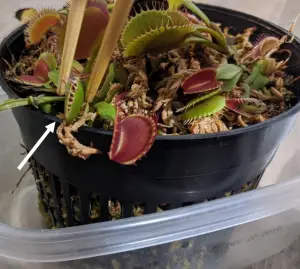
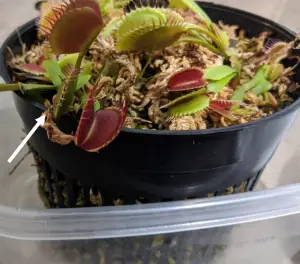
Step 6: Wait and verify the plant started digesting the food
Now, you are all done. Keep an eye on the trap during the next hours. It should remain close for several days or even weeks while it digests the prey. If the leaf starts turning black, it is very likely that the feed was too large for the trap. Next time, choose a smaller portion for your plant.
Feeding Live Bugs
Step 1: Select the right size of bug
Do not attempt to overfeed a Venus flytrap. Carefully select a bug that can fit completely in between the two lobes. Follow the 1/3 of the size of the trap sizing rule. If your plant is too small to handle the victim. It is better to skip feeding.
Step 1: Prepare the bug
Live bugs, do not need any extra prep before you feed them to a Venus flytrap. However, here are a few suggestions for handling the insect:
- Use a small tool you feel comfortable with to secure the bug. Tweezers are usually a good option to set a live bug in place.
- Consider placing the bugs in the freezer for a few minutes. The cold will stun them and confuse them.
- Avoid choosing live insects that can fly away. Those are a real challenge
Step 2: Hold the bug and place it inside the trap
- Use a small tool or your hands to pick up the bug.
- Carefully set it in the center of the trap.
- Make sure you touch the trigger hairs inside the Venus flytrap lobes when you place the bug.
- The leaf should close and keep the bug in place. However, it will only go into a semi-closed stage.
- The movement of the victim trying to scape will continue to stimulate the trigger hairs inside the trap.
You do not need to stimulate the traps or do anything else. The movement of the bug will ensure the trap closes completely. Once that happens, the plant will drown the insect with enzymes and starts digesting it.
Step 3: Wait and verify the trap is fully closed
Keep an eye on the plant for a few minutes. Some bugs can try to escape from the plant by eating their way out or using brute force. Then, monitor the trap in the next weeks to ensure the feeding was successful.
At the end of the process, the leaf will reopen and expose the exoskeleton and any other remains of the victim.
Related Questions
Why Do Venus Flytrap Consume Bugs?
Venus flytrap capture bugs to supplement their diet. In their natural habitat, Venus flytraps live in very poor soil which lacks nutrients. Some scientists hypothesize Venus flytraps chose such an environment because of the lack of competition for the soil.
Still, the Venus flytrap needed access to key nutrients such as Nitrogen, Phosphorus, and Potassium, which were not present in the environment. As a result, Venus flytraps evolved to be successful predators. The traps in a Venus flytrap are modified leaves that have developed a trapping mechanism. When a Venus flytrap captures an insect, it closes and starts producing digestive enzymes inside the trap. The plant digests the bugs and extracts key nutrients to supplement their diet.
Do Venus Flytraps Need Bugs to Survive?
Venus flytraps consume bugs, but do they need them to survive?
Venus flytraps do not need bugs to survive. Like the other plants, Venus flytraps produce their own food through the photosynthesis process. For that reason, Venus flytraps require great amounts of sunlight and water to survive.
Even though the bugs are not required for the plant’s survival, they benefit from capturing prey. The nutrients they extract from their victims supplement their diet and boost their growth, especially when the plant is young.
Why Won’t a Venus Flytrap Eat?
Venus flytraps can start consuming bugs from a very young age. As soon as they are large enough to capture prey, they will start consuming them. In rare scenarios, Venus flytraps do not consume prey. This is not common in the wild, but it can be in other environments.
Here are a few reasons why a Venus flytrap is not consuming insects:
- Improper care: if the Venus flytrap is sick, suffering from a pest infestation of not receiving nearly enough light, the traps might not work properly. The plant is focused on surviving, rather than capturing prey.
- Dormancy: During dormancy, Venus flytraps go into a resting stage. During that period, Venus flytraps do not need to consume prey. They are just focused on resting rather than growing.
- Dying leaves: venus flytraps are constantly changing old leaves for new ones. A trap might not close because it has started withering. You might notice some black coloring on the edges that will expand through the whole branch. A dying leaf is not useful for capturing and consuming bugs. However, it will still participate in the photosynthesis process.
Recommended Products for Growing Carnivorous Plants
Finding the best pots, lights, and soil for carnivorous plants is difficult. I have grown carnivorous plants for over 5 years, and these are the products I use. The links will take you to Amazon to view the prices and full specs:
- Carnivorous Plant Soil
- Carnivorous plant soil: https://amzn.to/422yLZa

- Carnivorous plant soil: https://amzn.to/422yLZa
- Artificial Lighting
- Small plant light for 1-2 plants: https://amzn.to/3oQsmSj

- T8 LED light fixture for multiple plants (6500k Cool White): https://amzn.to/3uWoeh2

- Small plant light for 1-2 plants: https://amzn.to/3oQsmSj
- Pots and Miscellaneus
- Nursery pots for single plants: https://amzn.to/3oL8YGq

- Nursery pots for single plants: https://amzn.to/3oL8YGq
- TDS meter to measure water quality: https://amzn.to/3g8VKLI

- Dried crickets to feed carnivorous plants: https://amzn.to/34QEnKv

